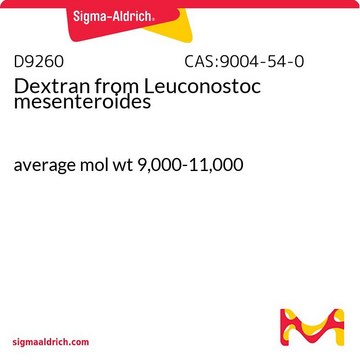FD150S
Fluorescein isothiocyanate–dextran
average mol wt 150,000
Synonym(s):
FITC–Dextran
Sign Into View Organizational & Contract Pricing
All Photos(2)
About This Item
Recommended Products
biological source
synthetic
conjugate
FITC conjugate
form
powder
mol wt
average mol wt 150,000
extent of labeling
0.003-0.025 mol FITC per mol glucose
color
faint yellow to orange
solubility
H2O: 25 mg/mL, clear to slightly hazy, yellow-orange
storage temp.
2-8°C
Looking for similar products? Visit Product Comparison Guide
General description
Dextran is a polymer of anhydroglucose. It is composed of approximately 95% alpha-D-(166) linkages. The remaining (163) linkages account for the branching of dextran. Conflicting data on the branch lengths implies that the average branch length is less than three glucose units. However, other methods indicate branches of greater than 50 glucose units exist. Native dextran has been found to have a molecular weight (MW) in the range of 9 million to 500 million. Lower MW dextrans will exhibit slightly less branching and have a more narrow range of MW distribution. Dextrans with MW greater than 10,000 behave as if they are highly branched. As the MW increases, dextran molecules attain greater symmetry. Dextrans with MW of 2,000 to 10,000, exhibit the properties of an expandable coil. At MW below 2,000, dextran is more rod-like. The MW of dextran is measured by one or more of the following methods: low angle laser light scattering, size exclusion chromatography, copper-complexation and anthrone reagent colorometric reducing-end sugar determination and viscosity.
Application
Dextran labeled with fluorescein isothiocyanate for possible use in perfusion studies in animals.
FITC-dextran is used extensively in microcirculation and cell permeability research utilizing microfluorimetry. FITC-dextran has been used to study plant cell wall porosity and capillary permeability. Plasma proteins have been shown not to bind to FITC-dextran.
FITC-dextran is used in cardiovascular, microcirculation, perfusion, cell monolayer and cell membrane permeability research as fluorescent flux tracer compound that supports the measurement of processes such as blood flow, membrane damage, vascular drainage and renal elimination. Small FITC-dextrans are also used to measure processes such as endocytosis and cell junction permeability. Fluorescein-dextran, 150 kDa may be used to help assess the integrity of the blood brain barrier (BBB) and to perform fluorescence microlymphography (FML). Fluorescein-dextran 150 is used as a microcirculation vascular flux tracer.
Preparation Note
Sigma typically tests the solubility of FITC dextrans in water at concentrations at or above 25 mg/ml. Solutions should be protected from light. In vivo, FITC-dextran is stable for more than 24 hours.
Other Notes
To gain a comprehensive understanding of our extensive range of Dextrans for your research, we encourage you to visit our Carbohydrates Category page.
Signal Word
Warning
Hazard Statements
Precautionary Statements
Hazard Classifications
Eye Irrit. 2 - Skin Irrit. 2 - STOT SE 3
Target Organs
Respiratory system
Storage Class Code
11 - Combustible Solids
WGK
WGK 3
Flash Point(F)
Not applicable
Flash Point(C)
Not applicable
Personal Protective Equipment
dust mask type N95 (US), Eyeshields, Gloves
Choose from one of the most recent versions:
Already Own This Product?
Find documentation for the products that you have recently purchased in the Document Library.
Federico Andrea Moretti et al.
eLife, 7 (2018-09-07)
The role of integrin-mediated adhesion during T cell progenitor homing to and differentiation within the thymus is ill-defined, mainly due to functional overlap. To circumvent compensation, we disrupted the hematopoietic integrin regulator kindlin-3 in mice and found a progressive thymus
Jesús E Rojo Arias et al.
Journal of neurochemistry, 153(3), 390-412 (2019-09-25)
Retinal hypoxia triggers abnormal vessel growth and microvascular hyper-permeability in ischemic retinopathies. Whereas vascular endothelial growth factor A (VEGF-A) inhibitors significantly hinder disease progression, their benefits to retinal neurons remain poorly understood. Similar to humans, oxygen-induced retinopathy (OIR) mice exhibit
A Bollinger et al.
Lymphology, 40(2), 52-62 (2007-09-15)
Fluorescence microlymphography (FML) is an almost atraumatic technique used to visualize the superficial skin network of initial lymphatics through the intact skin of man. Visualization was performed with an incident light fluorescence microscope following subepidermal injection of minute amounts of
Takayuki Ishii et al.
Brain research, 1321, 164-168 (2010-01-26)
Ischemia-reperfusion injury is induced by recovery of blood flow after ischemia. This phenomenon is a main cause of ischemic brain injury. The integrity of the blood-brain barrier (BBB) fails after cerebral ischemia and reperfusion. Further elucidation of this phenomenon promotes
Jiyun Kim et al.
Advanced materials (Deerfield Beach, Fla.), 28(1), 132-137 (2015-11-10)
Biomimetic extracellular matrix (ECM) topographies driven by the magnetic-field-directed self-assembly of ECM protein-coated magnetic beads are fabricated. This novel bottom-up method allows us to program isotropic, anisotropic, and diverse hybrid ECM patterns without changing other physicochemical properties of the scaffold
Our team of scientists has experience in all areas of research including Life Science, Material Science, Chemical Synthesis, Chromatography, Analytical and many others.
Contact Technical Service





